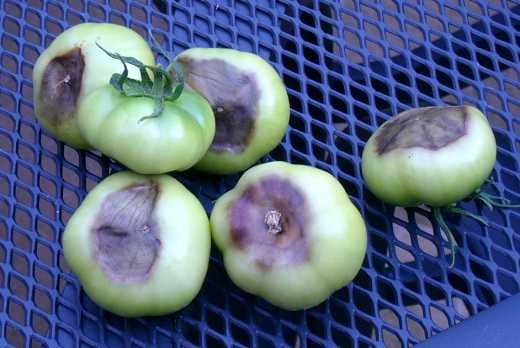Blossom end rot is a tomato disorder where he base of the fruit flattens, eventually becoming concave, and goes brown, remaining hard, despite the name “rot”. It appears at the blossom end of the fruit, the end away from the stem which gives it its name and nowhere else.

Aubergines and peppers, both closely related to tomatoes can also suffer from blossom end rot although it is thankfully rare in them.
Causes of Blossom End Rot in Tomatoes
Blossom end rot is not a disease or the result of pest damage, it is a physiological disorder. A result, that is, of something being wrong with the way the plant is working. The root cause of the problem is irregular watering. Lack of available water in the growing medium leads to a calcium deficiency in the fruit as the plant has difficulty moving calcium to the fruit and diverts it to the stem and foliage.
The most problematic time is 16 to 21 days after the flower has pollinated. At this point the tomato fruit has started to form. This is why you can have one truss affected by blossom end rot and another clear of the problem
Blossom end rot rarely effects tomatoes grown outdoors or in border soil in a greenhouse or polytunnel but it is very common in tomatoes grown in containers or grow bags, especially in hot weather. This is because the compost is most likely to dry out in containers and especially in hot weather. Even a matter of some hours dryness, say between morning and evening is enough to cause the problem.
Damage to the roots can prevent the uptake of water and calcium, perhaps caused by weeding in a border or exposed roots being burned by hot sunlight in a greenhouse.
Nutrient Imbalance (Excess Potash)
The condition can also be caused by an imbalance of nutrients. Very high levels of potash have been shown to restrict the uptake of calcium and this also leads to blossom end rot. A build up of potash can easily happen if you use a high potash fertiliser as is recommended for tomatoes. Potash does not wash out of the soil as easily as calcium does and many soil-less composts are low in calcium to start with.
Prevention of Blossom End Rot
Watering
The first thing is to ensure your tomatoes get enough water and that the compost or growing medium is never allowed to completely dry out. Drenching and drought is the worst thing you can do for tomatoes as it also causes split skins which allow rot and fungal moulds to develop.
If you cannot get to your plants frequently enough, which can be three times a day in hot sunny weather, consider automating watering with micro-drip systems or leaky porous hoses and timed water controls. See Tomato Water Requirements for guidance on how much water tomatoes require under different conditions.
Proper watering will prevent 90% of cases of blossom end rot.
Fertiliser Use
Do not over apply high-potash tomato fertilisers. It’s always a temptation to use a little extra thinking this will result in more and better crops. Unfortunately the opposite can result. It’s true that tomatoes require frequent feeding to give of their best but it’s often worth replacing one in three feeds with a standard balanced liquid fertiliser or high nitrogen fertiliser such as Miracle Gro to avoid overdosing on potash.
Curing blossom end rot
Restore a normal watering regime that does not allow the compost to dry out. This will solve the problem in the vast majority of cases. If fruits continue to be affected and developing the problem then you need to restore the calcium / potash balance.
To restore the calcium levels in the plant, give a foliar feed with calcium nitrate three times a week for two weeks and replace one normal feeding by watering with calcium nitrate.
Calcium Nitrate Foliar Feed Application Rate
Mix 1 level teaspoon (5ml) of calcium nitrate per litre of water and spray.
Calcium Nitrate Liquid Feed Application Rate
Mix a solution at a lower rate of 1 level teaspoon (5ml) of calcium nitrate per 5 litres of water and give each plant half a litre every fortnight.
Further Information: Tomato Growing Guides
- Tomato Blight – Blight Resistant Tomato Varieties
- Tomato Blossom End Rot | Causes & Cures for Tomato Blossom End Rot
- Tomatoes Magnesium Deficiency – Yellow Leaves, Epsom Salts
- Grow Unusual Tomatoes!
- Types of Tomatoes – An Introduction to Tomato Growing Part 1
- Sowing and Starting off Tomatoes – Introduction to Tomato Growing Part 2
- Growing Tomatoes in a Tomato Grow-house (Mini-Greenhouse)
- Growing Tomatoes in a Greenhouse
- Growing Tomatoes in the Greenhouse Border
- Growing Tomatoes in Pots or Grow Bags in the Greenhouse
- Growing Tomatoes by Ring Culture
- Growing Tomatoes in Straw Bales
- Growing Tomatoes Outdoors
- Planting & Growing Tomatoes Outdoors
- Growing Patio Tomatoes – Dwarf Bush Variety Patio Tomatoes
- Water Requirements for Tomatoes
- Ideal Temperatures for Growing Tomatoes
- Removing Tomato Side Shoots (Suckers) & Stopping Tomatoes
- Best Tomato Varieties – My Top Tasty Tomato Picks
- Heirloom Tomatoes (Heritage Tomatoes)
- Best Tomatoes for Greenhouse Growing
- Tomato Troubles & Diseases | Causes & Cures of Tomato Problems
- Raising Tomato Plants from Seed



